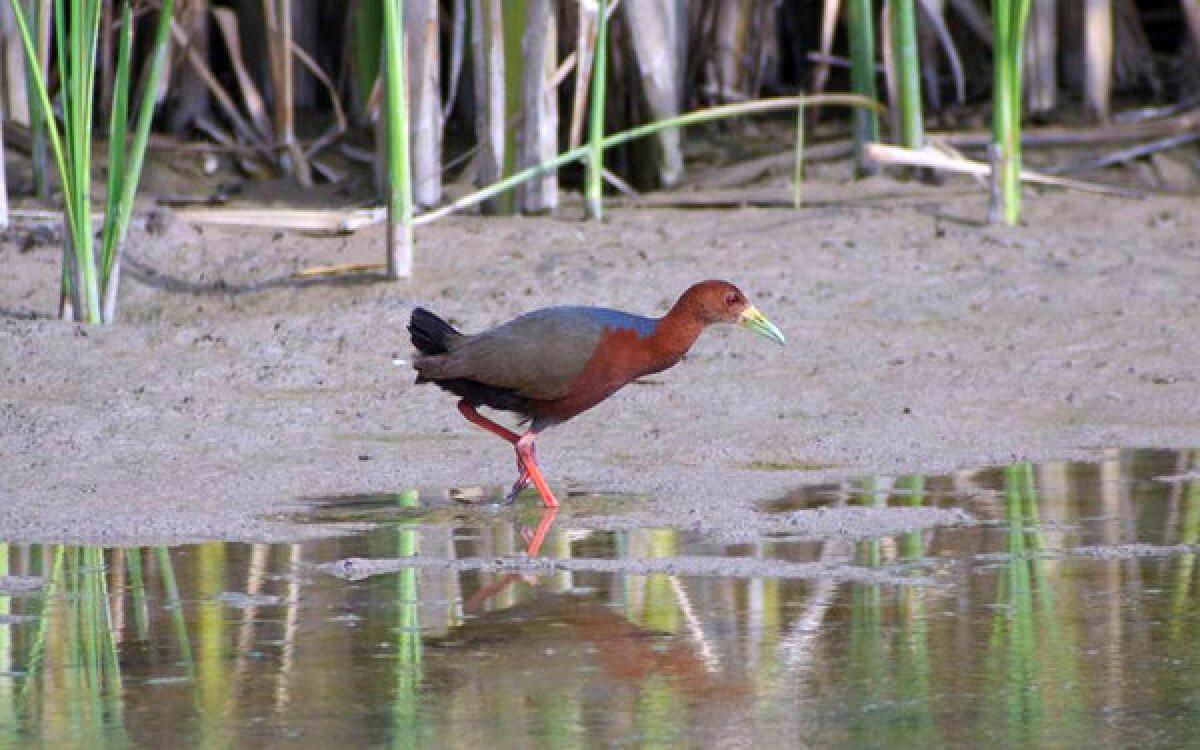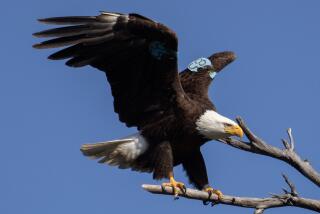Crowds flock to New Mexico for sight of rare tropical bird

America’s first Rufous-necked Wood Rail may have already ended its improbable stop among New Mexico cattails, but his celebrity hasn’t diminished.
Thousands of people in recent weeks have made a pilgrimage to Bosque del Apache Wildlife Refuge to see what, in the birding world, is a singular discovery: the first North American sighting of the Wood Rail, a native to South and Central American tropical forests.
The Wood Rail hasn’t been spotted since last Thursday, stirring speculation of a retreat into the brush or a return to the tropics, but birders are still buzzing over the unlikely find.
Jeffrey Gordon, president of the American Birding Assn., jumped into his car in Colorado Springs the moment he heard of the bird’s sighting on June 7.
Six and a half hours later, against his more prudent expectations, Gordon was standing before his tropical quarry in a New Mexico marsh. He said Wood Rails spend their lives trying to remain concealed, making them a rare find even in their native habitat.
Arid New Mexico, then, makes for an unexpected stop for this bird the size of a small chicken. Despite their rather dowdy name, Rufous-necked Wood Rail are distinguished by their stunning color: deep red chest and neck, greenish-yellow bill, a splash of blue on the back and slender bubble-gum pink legs.
“You could compare it to amateur astronomers discovering a comet,” Gordon told the Los Angeles Times. “Most of them are small, and only hard-core astronomers care. But every once in a while, one gets really bright. This is that comet.”
Matt Daw, 19, was taking video of a Least Bittern gingerly walking over the mud when out from the cattails strutted the Wood Rail in the background. Daw was so stunned that his hands started shaking -- as a YouTube video of the encounter shows -- and he finally stopped shooting. He grabbed his binoculars for a better view.
“Birders are calling it the best photo-bomb in birding history,” Aaron Mize, deputy refuge manager, said. “The Wood Rail photo-bombed the Least Bittern.”
Word has since spread quickly across the tight-knit American birding community. But it’s been the bird’s popularity on social media, observers said, that sparked fanatical quests among even casual birders. Visitors have arrived from as far as California, Virginia and Florida -- even Australia.
“It was kind of a party, with so many people rolling in,” said Ashli Gorbet, an Albuquerque ornithologist, who helped recruit New Mexico birders to the scene.
One Iowa man flew into Denver and drove seven hours in a rental car to Bosque del Apache, only to find that the Wood Rail was gone. The man had already returned to Denver for his flight home when he got a call: The Wood Rail had reappeared.
Refuge officials said he promptly rescheduled his flight, retrieved the rental car and returned to New Mexico in hopes of adding the Wood Rail to his lifetime “list” of birds. He got his bird.
Near the refuge, the rural town of San Antonio has capitalized on the Wood Rail’s sudden renown. Zooila Armijo, owner of a Mexican restaurant called the San Antonio Crane,said her five-table eatery has been doing brisk business. Her one waitress has pulled in hundreds of dollars in tips each day.
Experts say unusual conditions in the Bosque del Apache marshes have lured otherwise secretive species, including the Wood Rail and Least Bittern, into the open. Cloudbursts of rain recently raised the water level, bringing fish -- and their avian predators -- to the edge of the mud. Whether out of naivete or comfort, birders said, the Wood Rail has become a cooperative performer, parading about in the open.
Mize, the deputy refuge manager, suspects a recent drop in the water level may be responsible for the bird’s disappearance. Refuge officials have begun adding water to the marsh in an attempt to seduce the Wood Rail to come back into the open.
But it’s equally likely that the Wood Rail has flown home, Mize said. Despite his new fame, breezes, not crowds, dictate the bird’s day. He came a long way.
ALSO:
Carlos Danger: The man, the myth, the reality
Natural gas rig blows out, is on fire off Louisiana coast
Las Vegas police officer who died rescuing hiker is remembered
Twitter: @benjmueller
More to Read
Start your day right
Sign up for Essential California for news, features and recommendations from the L.A. Times and beyond in your inbox six days a week.
You may occasionally receive promotional content from the Los Angeles Times.






